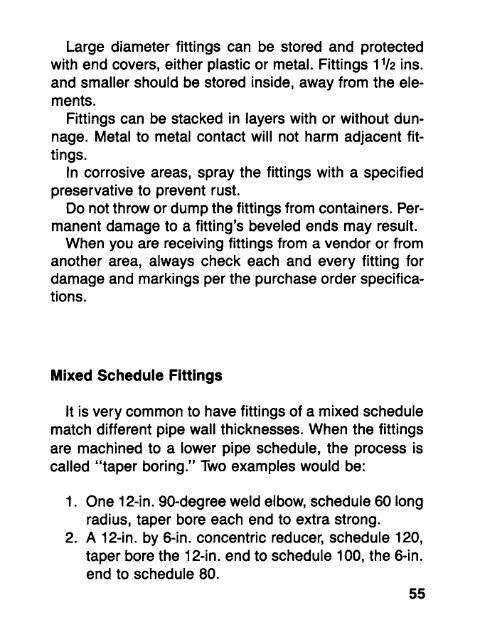You also want an ePaper? Increase the reach of your titles
YUMPU automatically turns print PDFs into web optimized ePapers that Google loves.
Large diameter fittings can be s<strong>to</strong>red and protected<br />
with end covers, either plastic or metal. Fittings 1 ~/2 ins.<br />
and smaller should be s<strong>to</strong>red inside, away from the ele-<br />
ments.<br />
Fittings can be stacked in layers with or without dun-<br />
nage. Metal <strong>to</strong> metal contact will not harm adjacent fit-<br />
tings.<br />
In corrosive areas, spray the fittings with a specified<br />
preservative <strong>to</strong> prevent rust.<br />
Do not throw or dump the fittings from containers. Per-<br />
manent damage <strong>to</strong> a fitting's beveled ends may result.<br />
When you are receiving fittings from a vendor or from<br />
another area, always check each and every fitting for<br />
damage and markings per the purchase order specifica-<br />
tions.<br />
Mixed Schedule Fittings<br />
It is very common <strong>to</strong> have fittings of a mixed schedule<br />
match different pipe wall thicknesses. When the fittings<br />
are machined <strong>to</strong> a lower pipe schedule, the process is<br />
called "taper boring." Two examples would be:<br />
1. One 12-in. 90-degree weld elbow, schedule 60 long<br />
radius, taper bore each end <strong>to</strong> extra strong.<br />
2. A 12-in. by 6-in. concentric reducer, schedule 120,<br />
taper bore the 12-in. end <strong>to</strong> schedule 100, the 6-in.<br />
end <strong>to</strong> schedule 80.<br />
55
















